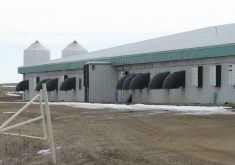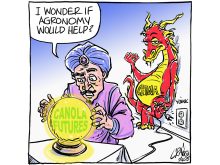Western Producer staff
Paul Earl, manager of corporate affairs for United Grain Growers, draws a laugh with a true-life story of bureaucratic pretension.
A couple of decades ago, he was a young buck in the federal government, working with Otto Lang’s grains group.
One day, a discussion broke out about problems and inefficiencies in the grain handling and transportation system. Someone declared that Ottawa should put “the full momentum of the federal government” into fixing the problems.
A wit at the meeting retorted: “I have the vision of a 10-ton snail.”
Read Also

Determining tariff compensation will be difficult but necessary
Prime minister Mark Carney says his government will support canola farmers, yet estimating the loss and paying compensation in an equitable fashion will be no easy task, but it can be done.
Well, two decades later, the snail is still alive and about to get loaded down with a tonne of new baggage by an activist government with reform on its mind.
For farmers who would be affected by some or all of these changes, the key question is whether the snail can move any more quickly and decisively now.
If so, do its drivers want it to move in the right direction?
After all, the agenda for a meeting on western grain transportation problems in 1994 would look much like the agenda for that 1972 meeting. Little has been resolved, despite all the policy water under the bridge since then.
Mind you, the much-maligned system does move almost double the grain now that it did 20 years ago. Still, there are the complaints of inefficiency. Once again, fixing it is on the agenda.
And there is more, much more.
In recent weeks, senior Agriculture Canada officials have been offering MPs a glimpse of the to-do list.
It includes:
- Renegotiating the entire farm safety-net system with provinces and farmers.
- Reorganizing the department to change the focus from subsidy and survival to rural revitalization and growth through exports and value-added products.
- Redesigning the supply management system.
- Re-examining the entire basket of prairie grain policies, from how subsidies get paid to how the Canadian Wheat Board should operate and whether the system should become less bureaucratic and regulated.
This doesn’t take into account the inevitable unexpected crises that will surface to consume government time, attention and resources.
Deputy agriculture minister Rob Wright, whose job it is to transform what was a Conservative government support group into a Liberal government support group, calls it “an ambitious agenda for change.” No kidding.
Part of it is being forced on Canada by new changes agreed to in the world trade talks. Part of it is a reflection of a new government in charge with dreams of fixing what it thinks is broken.
The bureaucrats are getting ready for a year or two of frenzied activity. Farm sector leaders should make a lot of time in their schedule for “consultations.”
And farmers, in whose name all this supposedly is being done, should be letting their leaders know what they want done. Then, they can settle back and watch to see if the 10-ton snail has gotten any faster over the years.
















